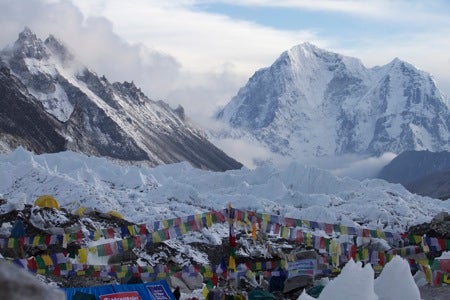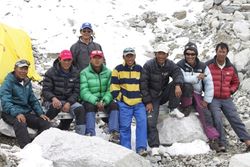
Six a.m. at Everest Base Camp and I wake to the sound of a Nepali screaming into a cell phone. A few days ago a new cell tower was installed at Gorak Shep (translation: Dead Bird), the last Khumbu Valley outpost a thousand feet below us, and the climbers and Sherpas are happy. If they aren’t cycling up the mountain to acclimatize or resting down valley, they’re texting or talking on the phone.
The latest news they’re likely reporting is that nine Sherpas fixed the ropes up the Hillary Step, then reached the summit at 11:38 on May 5, which means Everest is ready for the 400-plus climbers hovering at Base Camp. and , the Climbers, are acclimatized and ready to go, but the jetstream at the top is blowing up to 80 mph, putting their summit push on hold for a few days.
As I fumble around in my tent, I listen to the tape of Buddhist chanting wafting over from our neighboring camp. The striped tent next door belongs to the 57-year-old “Ice Doctor,” Ang Nima Sherpa, and his crew of Sherpas who fix the route of ropes and ladders through the Icefall. Ang Nima’s job is potentially the most dangerous on the mountain, but he told me yesterday that he relies heavily on Buddha and leaves the rest to luck.
“There’s some danger, but every day I pray to Buddha and Buddha helps,” he says. Plus, he adds, his job is relatively lucrative for a Sherpa. “No money, no honey,” he laughs.

When we arrived a few days ago, , the climber from Seattle who is trying to break the solo speed record without oxygen, stopped by for a visit. He had just returned from a rest day in Tengboche.
Just above our campsite is Everest ER, the medical emergency tent established by Dr. Luanne Freer eight years ago. We passed Freer on the trek up. Her work at Base Camp is done for the season, but , the legendary high-altitude expert and author of , has officially taken over. Yesterday he was attending to a climber who started passing gallstones at Camp I. That must have been a painful climb down the Khumbu Icefall.
Yesterday I took a walk to the base of the Icefall. Now I understand why it makes climbers queasy. To navigate the vertical maze of ice, which is constantly moving down the mountain and decaying in the sun, would be like being trapped in a video game with Ninja warriors chasing you. A few days ago, the Expedition Hanesbrands Sherpas, Kami Tsering, Arita (brother to the famed ), Ang Namgal, Pemba Dorje, and Sonam, came within a second of being crushed by a falling ice tower. It was a close call.
“No sound mountaineer would enter the Icefall if it weren’t for the jewel of Everest beyond,” says Jamie Clarke.
–Stephanie Pearson